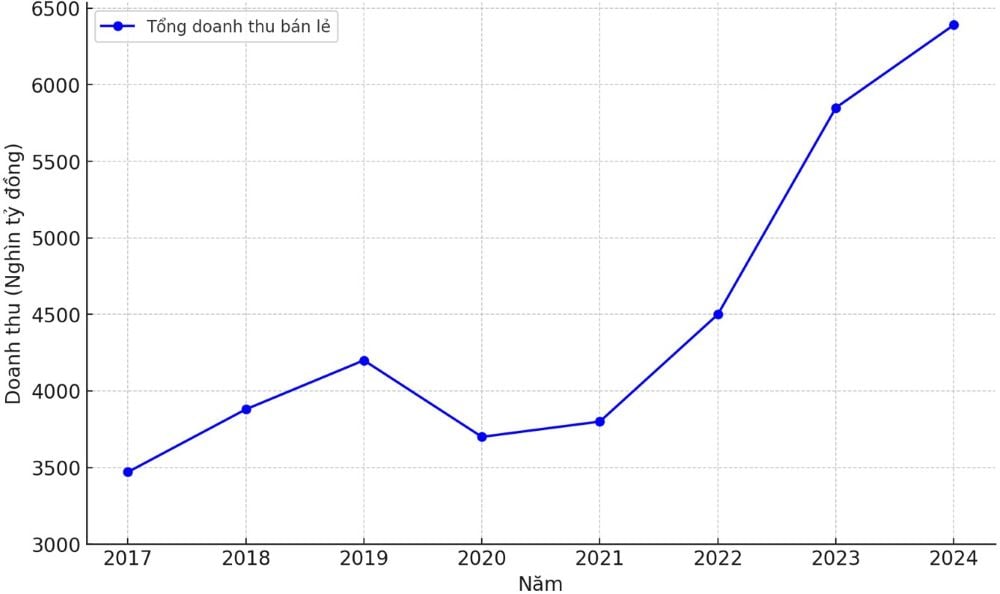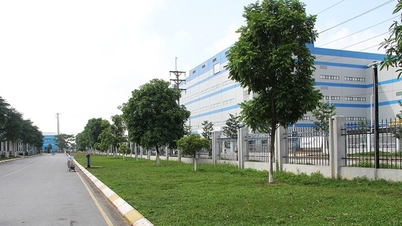The current status of digital transformation of enterprises in Vietnam
Digital transformation is considered one of the important strategies to improve the efficiency of work processing in most fields in many countries around the world. In Vietnam, Resolution No. 52-NQ/TW of the Politburo , dated September 27, 2019, emphasized that proactive and active participation in the Fourth Industrial Revolution is a particularly important strategic task. According to the Prime Minister's National Digital Transformation Plan to 2025 and orientation to 2030 (Decision No. 749/QD-CP), the goal of the digital economy is to reach 20% of GDP by 2025 and 30% of GDP by 2030. Digital transformation in enterprises is considered an important solution to improve competitiveness and promote the digital economy. Resolution No. 57-NQ/TW, dated December 22, 2024, of the Politburo, "On breakthroughs in science and technology development, innovation and national digital transformation", continues to consider national digital transformation as one of the top important breakthroughs, the main driving force to rapidly develop modern productive forces, perfect production relations, innovate national governance methods, develop the economy - society, prevent the risk of falling behind, and bring the country to breakthrough development and prosperity in the new era.
The results of the Annual Report on Digital Transformation of Vietnamese Enterprises in 2022 (1) show that in the period of 2021 - 2022, enterprises have had positive changes in their awareness of digital transformation. However, the digital transformation process of many enterprises has not met expectations. Some enterprises are only in the digitalization stage and use new technologies in a fragmented manner, lacking synchronous connections. Nearly 50% of enterprises have previously applied some digital transformation solutions but are no longer using them because they are not suitable or the enterprises have applied them only to meet short-term needs due to the COVID-19 pandemic, but are no longer in need. Another reason is that many enterprises have not yet identified the right digital transformation goals and strategies, as well as lack of personnel to serve digital transformation in both quantity and quality. A few businesses have applied technology and management software to analyze data and automate decisions in production and business, but still face difficulties in innovating and upgrading technology.
The level of digital maturity of enterprises in different aspects varies between 2022 and 2023, in which the level of digital transformation readiness in the strategic orientation aspect reaches the highest level, the level of digital transformation readiness is most improved in the aspect of risk management and cybersecurity (2) . Overall, enterprises are focusing mainly on areas that directly affect revenue, such as distribution systems, marketing, sales and customer care. The survey results also show that technology is often applied to operations that directly affect revenue, such as distribution channels, marketing, sales and customer care. In addition to traditional sales, online sales have become more popular thanks to the support of many online sales platforms (Shopee, Lazada, Tiki, ...) and social media (Facebook, Instagram, Zalo, and Tiktok), with the majority of enterprises implementing multi-channel sales.
However, most businesses carry out digital transformation in a rather fragmented way, managing each function separately such as transportation, warehouse, sales, human resources and accounting without synchronization. About 20 - 30% of businesses regularly use digital technology in some operations. Specifically: in terms of transportation management activities, more than 60% of businesses rarely or rarely use digital software, only 23% use it regularly; more than 40% of businesses use digital technology at a high level in accounting activities, but 33% have not fully exploited the potential; meanwhile, more than 40% of businesses hardly or rarely use digital software in warehouse and human resources management activities (3) .
In addition, many businesses face challenges with budgeting for digital transformation. Of these, about 20% do not have a budget, and more than 40% have a budget but do not have enough funds to meet actual needs. Lack of budget, especially in small and medium enterprises, is a common challenge. The report also shows that businesses are confident in their knowledge for digital transformation, but they find it difficult to fully implement this process. Therefore, businesses need support at every stage of the digital transformation process, from standardizing operating procedures to building a roadmap and deploying technology solutions. One of the main challenges is the limited human resources dedicated to implementing digital transformation, with 56.3% of businesses having less than 3 employees in charge of digital transformation planning and strategy and 43.7% having less than 3 employees in the information technology department.

Overview of the retail industry in Vietnam
Vietnam continues to be considered a potential retail market on the global investment map. Along with the dynamic development of domestic companies, many foreign retail brands have entered the Vietnamese market, benefiting from the vibrant market and the policy of welcoming foreign investors. In particular, small and medium enterprises (SMEs) in Vietnam have many opportunities to carry out technical transformation and affirm that SMEs are the foundation for national economic development. The improvement of income and the increase of the middle class have created favorable conditions for the increasing appearance of branded and high-end products. Although traditional trade channels still account for a significant proportion, the trend of modern and multi-channel retail is increasingly dominant, as evidenced by the rapid expansion of supermarkets and shopping centers.
After being affected by the COVID-19 pandemic, the retail industry in Vietnam has strongly recovered and continued to grow steadily. According to data from the General Statistics Office, total retail sales of goods and consumer service revenue in 2024 will reach VND 6,391 trillion, up 9.0% compared to 2023. In the period 2017 - 2024, total retail sales of goods and consumer service revenue will increase from VND 3,470 trillion to VND 6,391 trillion, corresponding to an average annual compound growth rate (CAGR) of about 9.2%. Retail sales of goods alone account for about 75 - 82% of total retail revenue, reaching a CAGR of 8.6% during this period, including years affected by the pandemic. Consumer spending has improved thanks to interest rate cuts, VAT reductions and government support to address issues in the real estate and financial sectors. Overall, with a growing economy, large population, urbanisation, rising incomes and high living standards, Vietnam continues to be a promising retail market, with many favorable conditions for development.
In particular, in the first 6 months of 2025, total retail sales of goods and consumer services revenue are estimated at VND 3,416.8 trillion, up 9.3% over the same period last year. Ho Chi Minh City and Hanoi, the two major economic centers of the country, continue to contribute significantly to national retail revenue. This growth reflects strong consumer purchasing power, especially in the context of economic recovery and an expanding middle class. However, to maintain sustainable growth, the retail industry needs to continue promoting digital transformation, improving customer experience and optimizing the supply chain. At the same time, developing modern retail models and integrating online and traditional sales channels will be important factors to help the Vietnamese retail industry compete effectively in the region and globally.

In the first 6 months of 2025, retail sales of goods such as cultural and educational items, food, clothing and household appliances all recorded growth rates of 11.5%, 9.5%, 6.1% and 5.5%, respectively. In some localities, retail sales saw remarkable growth, such as Quang Ninh (10%), Hai Phong and Da Nang (8.2%), Ho Chi Minh City (7.9%), Can Tho (7.6%) and Hanoi (7.3%). Localities that recorded remarkable growth in revenue from accommodation and food services were Da Nang (18.5%), Ho Chi Minh City (16.9%), Hanoi (13%), Hai Phong (12.5%), Can Tho (9%).
The 2023 Kearney Global Retail Development Index (GRDI) has recorded a change in Vietnam's position in the retail industry. While in 2021, Vietnam ranked 9th out of 35 countries evaluated, in 2023, Vietnam ranked 34th out of 44 countries. Compared to previous years, Vietnam has dropped in rank, from 6th in 2017 to 9th in 2021 and currently 34th. Despite the drop in rank, Vietnam still maintains its attractiveness to international retail investors thanks to its strong growing economy, large and young population, political stability, urbanization and increasing income levels. These factors still create a potential market for the retail industry. The GRDI not only assesses the current attractiveness of a market but also reflects its future growth potential, based on factors such as country risk, market attractiveness, saturation and retail sales growth. The 2023 GRDI ranking shows India in the number 1 position, while other countries in the Asian region, such as Saudi Arabia (3rd), China (4th), Kazakhstan (7th), Malaysia (8th), and Indonesia (10th) all made it into the top 10. Vietnam ranked 34th, although it still surpassed the Philippines and Thailand, which ranked 41st and 44th. Other countries in the Asian region that made it into the ranking include Bangladesh (13th), Iran (26th), Pakistan (32nd), Nepal (35th), and Cambodia (42nd).
Digital transformation in the retail industry in Vietnam
According to the 2022 and 2023 Annual Digital Transformation Report of the Department of Enterprise Development, Ministry of Planning and Investment, the level of digital transformation readiness of enterprises in the retail industry is relatively high in the aspects of financial management, accounting, planning, legal and human resources. In the context of the COVID-19 pandemic, many enterprises have integrated technology to expand sales channels, conduct online communication and marketing, as well as online payments. Many companies have also applied information technology systems and data analysis to measure marketing, sales and customer care performance.
However, the connection between participants in the Vietnamese retail market is still not good, which is a big challenge in the digital transformation process. In addition, cyber security is a risky field, especially in the retail sector. The main target group is reputable companies, where a lot of financial and personal information of customers is stored.
In the period before 2020 (before the COVID-19 pandemic): The retail industry was one of the biggest sectors affected by the digital revolution, as digital transformation not only changed the needs and shopping habits of consumers, but also brought high personalization, enhanced experiences and convenience in every aspect, from the shopping process to shipping, delivery and payment. In addition to the traditional retail channel, in the late 2010s, online retail became a popular channel. By diversifying sales channels, the retail industry aimed to provide a seamless experience to customers, regardless of whether the final transaction was made online or offline. Retailers increasingly focused on understanding customer behavior across different channels, depending on age, gender and other factors. In addition, through more systematic customer data analysis, the retail industry aims to personalize customer approaches, instead of focusing on a certain segment as before.
In Vietnam, the retail industry is considered to have great potential due to the population size and urbanization rate. The urbanization rate is fast, with an average of 3.2% annually and expected to reach 50% by 2025 according to the World Bank (4) . Highly urbanized markets are often attractive to retailers, because logistics services are developed, consumers are concentrated in small areas and have high spending levels. With this potential and the development of technology, as well as the popularity of internet use, especially in urban areas and among young people in Vietnam, retail businesses have accelerated the digital transformation process in the industry. To meet the needs and new shopping habits of customers, the retail industry has shifted from traditional channels to modern retail chains, bringing convenience, quality, diversity and price transparency. This period has seen the rise of early adopters such as Tiki and Lazada, and the emergence of new retailers such as Shopee. The transformation of small and medium-sized retailers has also taken place based on customer needs and expectations. However, many businesses, especially small and medium-sized businesses, have encountered many challenges in the digital transformation process, including lack of resources, cultural barriers and few suppliers. This has led to some businesses having to stop in the race to compete in the retail industry.
Despite the sustained growth in retail revenue over the long term, e-commerce is increasingly dominating the market, however, the retail landscape in Vietnam is still dominated by traditional methods. Revenue from traditional stores and distribution channels accounts for 98% of retail revenue, while direct sales in stores account for about 97% and non-store sales (including e-commerce) contribute only about 3%. Before the COVID-19 pandemic in 2019, electronics and communication products, as well as fashion products, accounted for the top two sources of e-commerce revenue in Vietnam, at 27% and 24% respectively, while food and personal care products accounted for only 16% (5) .
Phase 2020 - 2024 : In 2020, the outbreak of the pandemic not only created temporary changes in consumer behavior but also forced retail businesses to quickly transform digitally to meet new market demands. Social distancing measures forced stores to close or reduce operations, and businesses were forced to optimize online sales channels to maintain revenue.
Digital transformation in retail is not just about shifting from a traditional sales model to online sales. This is a comprehensive change in the way businesses operate, from using advanced technologies such as artificial intelligence (AI), big data analysis, to optimizing payment and shipping processes. Technology not only helps improve the customer experience but also increases the ability to manage, analyze and predict consumer trends, helping businesses make accurate and timely decisions. Especially during the pandemic, digital transformation has created a strong change in consumer shopping behavior. The shift to a multi-channel shopping model, combining online and physical stores, has opened up new opportunities for businesses. They can reach and serve customers anytime, anywhere, through online platforms such as websites, mobile applications or e-commerce platforms. This also helps to minimize direct contact, accompanying the trend of safe shopping during the pandemic.
According to data from the General Statistics Office, although physical stores had to close for a long time, total retail sales and service revenue in the first 6 months of 2021 still increased by 4.9% compared to the previous year. In addition, the average annual growth of e-commerce and sales websites exceeded 30%, with an estimated value of about 10 billion USD, accounting for about 4.6% of GDP. It is forecasted that by 2025, this industry will continue to grow strongly and can reach a value of up to 35 billion USD, equivalent to 10% of the country's GDP. This result is thanks to the proactive application of technology solutions in transactions and payments. It is also thanks to digital platforms that retail businesses can maintain operations and connect with customers in a world disrupted by the pandemic.
Digital transformation is not just a temporary trend but is gradually becoming a long-term and inevitable business strategy for the retail industry. Businesses cannot delay the application of technology if they want to survive and develop in the future. Digital transformation helps businesses not only adapt to changes caused by the pandemic but also thrive, optimize business processes and bring added value to customers. In the future, successful retail businesses will be those that can apply technology flexibly and creatively.
Some policy recommendations
Digital transformation has played an important role in promoting the growth of the retail industry and maintaining stability for the business community. Digital transformation brings positive changes to the retail industry, changing sales methods, trading platforms, supporting businesses in management and creating trends to change consumer habits. The COVID-19 pandemic has forced businesses to change the way they operate, moving from offline to online to adapt and survive. At the same time, the globalization trend is opening up opportunities to access large markets but also poses fiercer competition requirements, requiring businesses to be flexible, agile and digital to keep up with the pace of the world. In particular, the Fourth Industrial Revolution with technologies such as artificial intelligence, big data, IoT, cloud computing, etc. is reshaping all production and business activities, forcing businesses, especially small and medium enterprises, to digitally transform if they do not want to be left behind. Therefore, in the coming time, retail businesses need to:
One is to change the traditional management method : To promote digital transformation in the retail industry, managers need to be ready to change traditional management methods. Management by old methods often lacks flexibility in the context of rapidly changing technology and businesses need to approach new management models based on data and digital technology. Managers can apply digital tools such as project management software, specific performance evaluation index systems to monitor the efficiency of each department, helping to optimize operations. At the same time, training and supporting employees to adapt to new technology is essential, ensuring they can operate digital tools effectively.

Second, enhance multi-channel customer experience : Integrating a management system on a technology platform helps optimize customer experience across multiple channels, both online and offline. Businesses can use inventory management and multi-channel sales software to ensure that product information, prices, and promotions are synchronized across all channels. This helps consumers easily track and search for product information, thereby improving the shopping experience and promoting purchasing decisions. Consistency in managing sales channels helps businesses retain customers more effectively and strengthen the bond between businesses and consumers.
Third, applying technology to management and operations : Retail businesses can use comprehensive management software to monitor every aspect of business operations, from order management, inventory control, to business data analysis. These systems provide real-time information, helping managers grasp changes promptly and make quick decisions. In addition, applying technology helps enhance employee management through productivity assessment tools and information access authorization.
Fourth, diversify payment methods : In the context of digital transformation, diversifying payment methods is an indispensable factor. Retail businesses should integrate electronic payment solutions, from credit cards, e-wallets (such as MoMo, ZaloPay) to online payment methods via banks or international payment systems (Visa, MasterCard). This not only creates convenience for customers but also helps businesses track and analyze transaction data more effectively, thereby improving business strategies. Flexible payment methods also promote the growth of e-commerce in the retail industry.
Five, integrate smart shipping systems : To improve the delivery process, businesses need to cooperate with leading shipping units to integrate the shipping system into the sales process. Customers will have more options for delivery methods and delivery times, creating a convenient and fast shopping experience. This system not only helps businesses track order status but also improves delivery accuracy, minimizing errors in the shipping process. This is especially important in contexts where online shopping is increasingly popular and a fast delivery experience can be an important factor in customer retention.
Sixth, use big data and advanced analytics : The application of big data and artificial intelligence in supply chain management and customer behavior analysis is becoming a global trend. Businesses can use data analysis tools to monitor and forecast customer demand, thereby optimizing the import process and warehouse management. Artificial intelligence also helps analyze customer data to propose personalized marketing campaigns, enhance consumer engagement and increase sales.
Seventh, optimize the digital supply chain: The supply chain is an important part of the retail industry and digitizing the supply chain helps businesses optimize operations and management. Digitizing the supply chain helps businesses better monitor the stages from production, import to delivery.
Eight, develop a digital ecosystem : A digital ecosystem includes comprehensive digital tools, platforms and processes, from data management, customer service, to internal operations. This ecosystem helps businesses increase connectivity between departments, improve productivity and create flexibility in operations. Moreover, a digital ecosystem also helps businesses easily scale and adapt to rapid changes in the business environment.
Nine, developing digital technology policies and infrastructure : Retail businesses need to invest in developing digital technology infrastructure, including high-speed internet, electronic payment systems and smart sales support devices. It is necessary to continue perfecting the legal framework for e-commerce and digital transformation, ensuring regulations on information security and consumer rights. This will create a favorable environment for businesses to develop and effectively promote digital transformation./.
----------------------
* The article is the research result of Project QG.22.80 "Building a tool to assess the level of digital transformation of retail enterprises in Vietnam" sponsored by the Science and Technology Development Fund of Hanoi National University
(1) See: Annual report on digital transformation of Vietnamese enterprises in 2022: Level of digital transformation readiness of Vietnamese enterprises , Department of Enterprise Development (Ministry of Planning and Investment), 2023
(2) See: Annual report on digital transformation of Vietnamese enterprises in 2023: Promoting digital transformation, green transformation , Department of Enterprise Development (Ministry of Planning and Investment), 2024
(3) See: Annual report on digital transformation of Vietnamese enterprises in 2022: Level of digital transformation readiness of Vietnamese enterprises , tlđd
(4) Delloite: Vietnamese Consumer Survey - Resilient in the Face of Difficulties , 2021
(5) See: General Statistics Office: Statistical Yearbook, Statistical Publishing House, Hanoi, 2021
Source: https://tapchicongsan.org.vn/web/guest/nghien-cu/-/2018/1143102/chuyen-doi-so-cua-cac-doanh-nghiep-nganh-ban-le-tai-viet-nam.aspx



![[Photo] Hanoi morning of October 1: Prolonged flooding, people wade to work](https://vphoto.vietnam.vn/thumb/1200x675/vietnam/resource/IMAGE/2025/10/1/189be28938e3493fa26b2938efa2059e)
































![[Photo] The 1st Congress of Phu Tho Provincial Party Committee, term 2025-2030](https://vphoto.vietnam.vn/thumb/1200x675/vietnam/resource/IMAGE/2025/9/30/1507da06216649bba8a1ce6251816820)
![[Photo] Panorama of the cable-stayed bridge, the final bottleneck of the Ben Luc-Long Thanh expressway](https://vphoto.vietnam.vn/thumb/1200x675/vietnam/resource/IMAGE/2025/9/30/391fdf21025541d6b2f092e49a17243f)
![[Photo] President Luong Cuong receives President of the Cuban National Assembly Esteban Lazo Hernandez](https://vphoto.vietnam.vn/thumb/1200x675/vietnam/resource/IMAGE/2025/9/30/4d38932911c24f6ea1936252bd5427fa)


























































Comment (0)